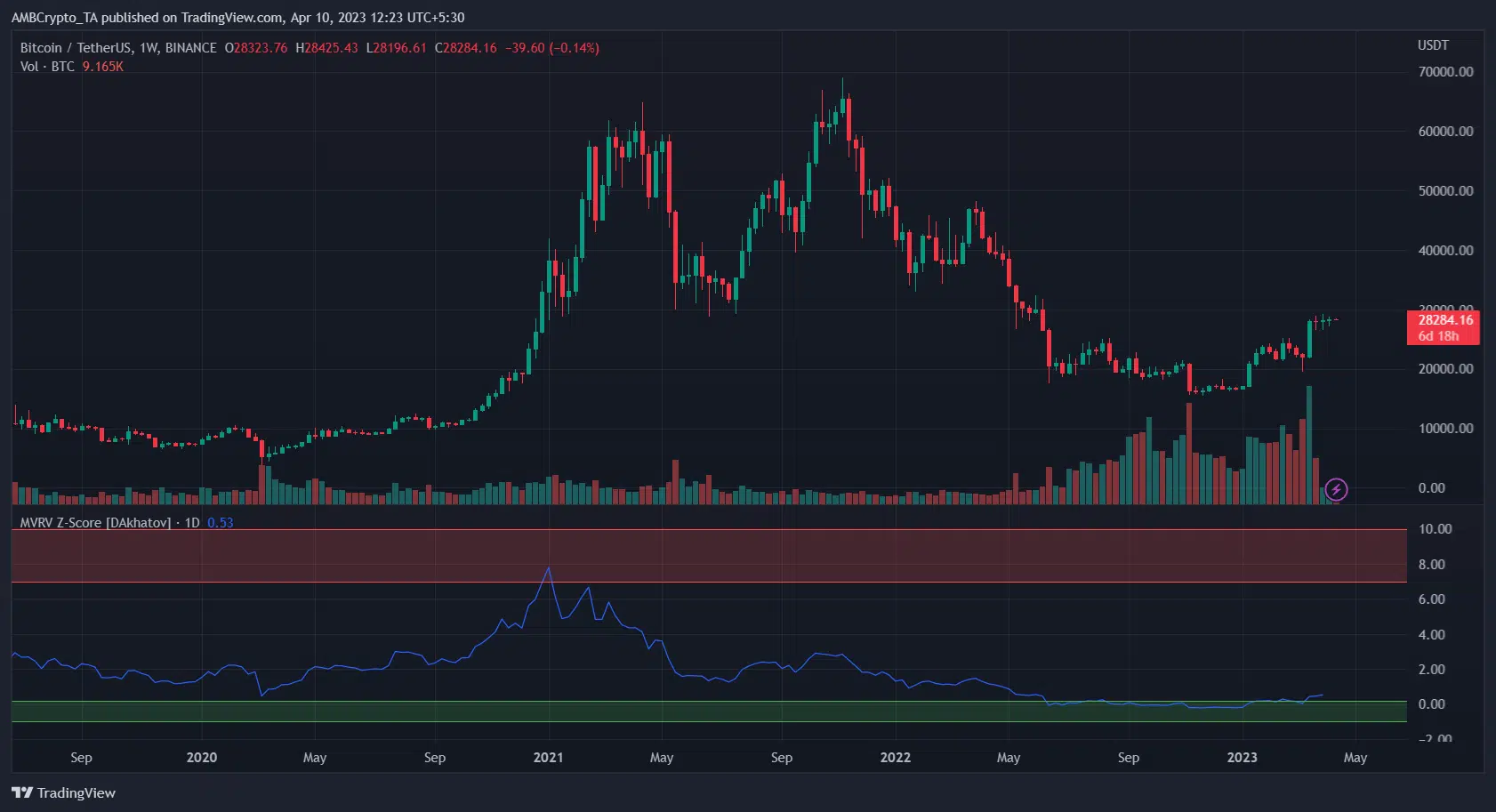Will 2023 be THE year for Bitcoin [BTC] despite the U.S huffing and puffing?
![Will 2023 be THE year for Bitcoin [BTC] despite the U.S huffing and puffing?](https://ambcrypto.com/wp-content/uploads/2023/04/AMBCrypto_The_Bitcoin_logo_walking_towards_the_sunset_in_a_beac_1cfb41bd-4667-44ba-817f-f5b61beae732.png.webp)
Q1 of 2023 was Bitcoin’s [BTC] time to shine. The king coin has not had a favorable run in the recent past. Notably, in 2022, Bitcoin’s price fell by 64.02% from its December 2021 prices. Its losses were compounded throughout the year, with Terra’s [LUNA] crash and FTX’s collapse leaving BTC in the middle of a dreadful crypto-winter.
In fact, Bitcoin hit a two-year low of $15,480 in November 2022, a fall that was made worse by macroeconomic factors. Similarly, its March 2023 gains were largely in part caused by the government’s assurance that depositors would have access to all their funds post Silicon Valley Bank’s collapse, thereby boosting investor confidence.
Joel Kruger, market strategist at LMAX Group, acknowledged Bitcoin’s 2023 growth as a positive sign, saying,
“The market has done a good job of pricing out most of the downside from the 2022 fallout and has been looking to take advantage of discounted prices and positive news around ongoing institutional adoption.”
However, the possibility of a setback due to macroeconomic factors remains as rate hikes, Federal Reserve decisions, and the United States’ reliance on its dollar stays prevalent. Even so, Kruger suggests that investors should remain bullish on Bitcoin. Especially as,
“Short-term setbacks are nothing more than compelling opportunities to build long-term exposure to Bitcoin. Investors will likely favor a deflationary, limited-supply, fully decentralized asset that’s been built to appreciate in value over time.”
As we step into Q2 of 2023, bullish sentiments may just prevail, especially with BTC trading at $28,293.31 at press time. Also, it’s worth considering this – Bitcoin’s 3-day MVRV ratio, at the time of writing, underlined the possibility of a sustained northbound trend.
Crypto’s rise and macroeconomic factors
2022 was undoubtedly crypto’s scariest year, with Terra and FTX crashing in May and November 2022, respectively. This was the perfect time for naysayers to emerge, who proclaimed that the end of crypto was near. These fears caused the industry to tank, pulling it down to a position it has struggled to get out of even at the time of writing.
However, the music changed in 2023 as there was an increased focus towards ensuring that those events do not take place again. But for that, the current crypto-structure would have to undergo an upheaval. This resulted in calls for increased accountability. Famously, the Chairman of the U.S. Securities and Exchange Commission Gary Gensler, said,
“This asset class is rife with fraud, scams, and abuse in certain applications.”
The SEC, in an attempt to crack down on unregulated securities, filed a case against Ripple Labs] in 2020, alleging that the latter was partaking in the sale of unregistered securities. The outcome of this lawsuit will set the tone for the entire crypto-space. Considering the United States’ status as a superpower, it will affect crypto globally as well.
If the SEC does win this case, most cryptocurrencies would have to fall under a “security” of some kind, marking it under a regulatory body’s umbrella.
However, what about cryptos like Bitcoin, whose owner is unknown? That is a question that remains unanswered as of yet.
Regulations across countries
The U.S is not the only country looking to regulate cryptocurrencies through the SEC, as other countries have also started looking to govern it through CBDCs. In 2023, 114 countries had started exploring the use case of CBDCs. 20 countries reached pilot or launch phases, including Australia, Thailand, India, and Russia. Jamaica is the latest country to launch its CBDC, titled JAM-DEX.
However, the most worrying part of it all is that the U.S continues to lag. The frameworks it has introduced, like the Biden Regulation, have been few and far in between. Despite these baby steps, no one has made any concrete moves yet. This is a worrying sign not just for U.S. crypto-investors, but for most countries as well.
The U.S, considering its status as a superpower, will lead the definition of what a cryptocurrency is. In fact, part of the reason why global adoption has not accelerated the way it should have is because of the world’s continued reliance on USD as a reserve currency.
Consider this – If the U.S. releases a dollar-based CBDC, it would significantly change the way countries trade with each other. International trade would become de-polarized, leading to increased liquidity. The debate over cryptocurrencies would largely cease, as most investors would prefer a government-backed and stable investment option with low volatility.
What’s causing the delay?
However, for some reason, U.S. lawmakers are unable to agree on uniform regulation for handling cryptocurrencies. This has, in a nutshell, fueled delayed adoption.
For example, SEC Chair Gary Gensler, a public advocate for crypto-regulations, has suggested,
“For those who want to encourage innovations in crypto, I’d like to note that financial innovations throughout history don’t long thrive outside of our public policy frameworks.”
As American lawmakers remain at odds over crypto-regulations, it begs the question – Will this back and forth affect America’s stance as a global financial hub? There is no doubt that recent state laws (like the recent Arkansas bill) have given some clarity as to states’ views on crypto. However, the arrest of Sam Bankman-Fried, a major crypto-player in Washington, has discouraged lawmakers from coming right out and voicing their opinions on the industry. This, much to the detriment of all those waiting for regulatory clarity from the country.
However, this wavering adoption is not a sign of discouragement. For example, this 23-year-old article that referred to the Internet as a “passing fad” and a “poor substitute” for the real world. Now, fast forward to 2023, and people are buying houses on DEXs as RWAs.
Bitcoin’s rise is testimony to investors’ confidence that the king coin will remain prevalent in the long term, and its 2023 gains are just the starting point. Regardless of what the macroeconomic events are, BTC will likely remain true to its “king coin” status, even though it may waver sometimes.







